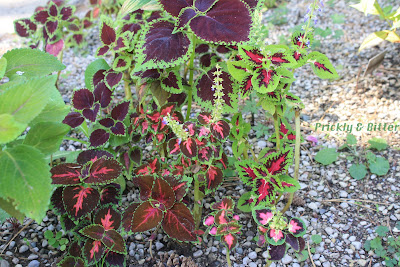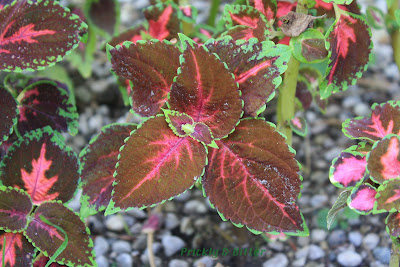Thursday, October 4, 2012
These be Kings of the coleus
Species name: Solenostemon scutellarioides (formerly Coleus blumei)
Common name: Coleus, King coleus, painted nettle
Location: Ontario
Contrary to popular belief, the genus name of this plant is not Coleus, and hasn't been since 1975. It's a rather long story for why the genus Coleus doesn't exist anymore, but to make it a short story it's because a really important botanist said "because I say so." When it comes to sequencing the DNA of all 6 species thought to once be part of the genus Coleus, it turns out that they actually fall into 3 distinct groups, two of which are new and the other is a well-established genus. All three of these groups are in the mint family. Because the previous genus name existed before the description of the first Coleus plant, the Coleus genus was dissolved. One of these three genera, Solenostemon, contains one of the most common garden plants in the world, the King coleus or the painted nettle. It is prized for its incredible degree of variation in colour in the leaves, with some varieties having as many as thirty different colours in one leaf. Most cultivars play on contrast, with very bright colours (or even white) being in combination with very dark colours (some almost appearing black). Why a plant would do this on its own is a mystery, but probably has to do with mimicry, herbivore detraction, or optimization of photosynthesis. We do know that most of the genes responsible for leaf colour in the coleus plant have mutations in them, which lead to the huge variety of colours you can see. Because these gene mutations were selected for by humans due to their visual appeal, the mutations are propagated in the population. This likely wouldn't have happened in nature, however, since changing a leaf's colour to anything other than green often leads to a decrease in photosynthetic ability, which in turn causes the plant to have an overall decrease in sugar production. This may not be a problem normally, but for a plant under any kind of stress (drought, heat, flooding, pest attack, etc.) this could be deadly.
For those of you who live in warm temperate climates (where the winter temperature rarely dips below 10 degrees), please exert extreme caution if you choose to plant a coleus outside (either in its native habitat or introduced areas). They do have the ability to be incredibly invasive despite being incredibly poor seed producers, so make sure you properly destroy of any cuttings you might take. Even a single leaf has the ability to root into a new plant just by having the petiole submerged in a puddle for a few days, and depending on the location as little as a few hours. Unless you like having coleus plants taking over your compost pile, do not compost the leaves or stem cuttings before shredding them! The native range of the coleus is enormous: tropical Africa, Asia and Australia, the East Indies, the Malay Archipelago (Malaysia, Indonesia, Papua New Guinea, Singapore, Brunei, and East Timor) and the Philippines.
A word of caution: this plant is toxic to most people when consumed. It was widely reported in the early 1800s that the Mazatec Indians near Oaxaca, Mexico, used this plant for its psychoactive and hallucinogenic properties and still do today. When consumed (either chewing leaves or brewing them in a tea), it can produce a feeling of euphoria and/or relaxation and some people have reported seeing hallucinations. These effects don't usually last long, but for a child this could not only be downright scary, but also could be dangerous to their health. There aren't any published adverse health effects, but better to be safe than sorry!
Subscribe to:
Post Comments (Atom)




No comments:
Post a Comment